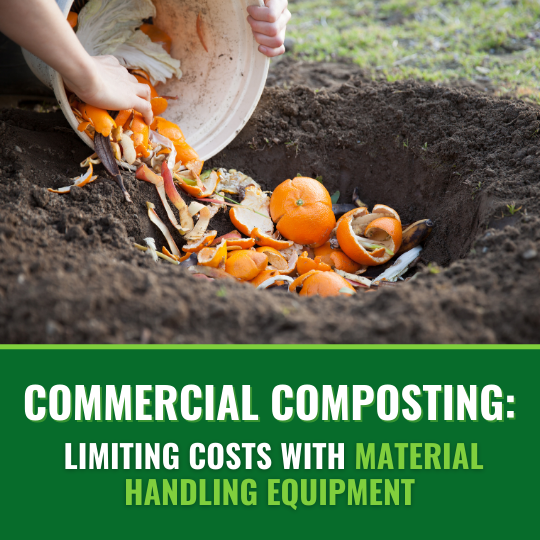We use cookies to make your experience better. To comply with the new e-Privacy directive, we need to ask for your consent to set the cookies. Learn more.
Commercial Composting: Limiting Costs with Material Handling Equipment
The success of a commercial composting operation rests on the ability to efficiently handle bulk materials. We know from studies of more conventional manufacturing facilities that material handling can contribute between 15 and 70 percent of operating costs — and it seems likely that composters will find themselves closer to the higher limit than the lower.
High material-handling costs aren’t just a problem, though. They’re an opportunity. Even the industry folks who came up with the “15-70 percent” figures point out that better material handling systems can bring down costs by 10 to 30 percent. (Those industry folks were Tompkins et al., who literally wrote the book on facilities planning, for the record.)
Tompkins and his colleagues were talking about facility layout — where exactly one unit in an assembly system sits in relation to the next — but the same principle holds for equipment itself. What does the moving is just as important to a composter as where the load is headed.
Determining the Value of Material Handling Equipment for Composters
As one experienced composter wrote in BioCycle, “Controlling costs is best done by analyzing costs.” The author recommends calculating the machine rate — the cost, per hour, of operating each discrete piece of equipment.
For those who don’t have the time to collect exact data on equipment and run them through a complex algorithm, a paper out of South Dakota State University provides the following rough estimates, which should hold in composting as well as they do in the agricultural industry, for which they were derived:
- For low-cost equipment — which is generally simple, without many moving parts or complex mechanisms, or is used only rarely — users can estimate a yearly operating cost of around 15 percent of the purchase price.
- Average-cost equipment will be a bit more complex than its low-cost counterpart. Alternately, assign a machine to the average-cost category if workers use it relatively frequently. Estimate these machines at an annual operating cost of 20 percent of the purchase price.
- High-cost machines will be full of moving parts, devoted to highly specific material-handling tasks, or so necessary to the composter’s operation that workers use it almost constantly. To get a rough idea of the yearly cost of running such a machine, take 25 percent of the purchase price.
Take these figures with a grain of salt; they were published in 2005, and serve mostly as examples. Still, they’re the closest general guidelines we could find for estimating machine rate prices. Anyway, it’s always better to generate highly dependable data by using exact methods when you have the resources.
Regardless of how it arrives, some idea of the hourly cost of using a new piece of material handling equipment is only half the equation. Composters must also project the productivity boosts, staffing changes, and safety benefits associated with each machine. Compare these two figures to generate not only a rough ROI projection, but cost-reducing effects over the entire lifespan of the equipment.
The Role of Bins and Bin-Handling Systems in Composting Facilities
We see considerable cost savings from equipment that allows a single employee to safely complete a material handling task that previously took two or more workers. Similarly, equipment that allows workers to handle larger containers often improve productivity, driving down per-unit compost-manufacturing costs.
A combination of Forward Bin Dumpers and Decade Bins prove this point. Large-volume Decade Bins accommodate greater loads of feed material and finished compost, with plenty of ventilation to prevent an anaerobic state from developing. Meanwhile, Bin Dumpers secure to lift truck forks, allowing a single employee to transport full loads, with a limit of more than 2,000 pounds (subject to forklift limitations).
At the end location, the Forward Bin Dumper safely empties materials into feedstock mixers, windrows, closed composters, filtering screens, or anywhere else it needs to go. Commercial composting operations looking to cut costs should consider the benefits of Bin Dumpers and associated bins.
References:
Coker, Craig. “Controlling Costs In Compost Manufacturing.” BioCycle. The JG Press Inc./BioCycle, Sept. 2010. Web. 30 Nov. 2018
Dangayach, G. S., Bhatt, H., Gupta, S., & Meena, M. L. (2016). Machine layout design through particle swarm optimization in indian industry. Productivity, 57(1), 13-31. Retrieved from https://search-proquest-com.ezproxy.slpl.org/docview/1793877833?accountid=14083
Pflueger, Burton. “How to Calculate Machinery Ownership and Operating Costs.” OpenPrairie. South Dakota State University Open Public Research Access Institutional Repository and Information Exchange, Feb. 2005. PDF. 30 Nov. 2018.

